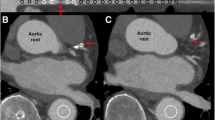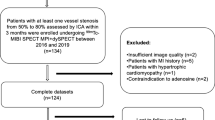Abstract
Background
We assessed the prognostic value of coronary flow reserve (CFR) estimated by single-photon emission computed tomography (SPECT) in patients with suspected myocardial ischemia.
Methods and Results
Myocardial perfusion and CFR were assessed in 106 patients using dipyridamole/rest Tc-99m sestamibi SPECT and follow-up was obtained in 103 (97%) patients. Four early revascularized patients were excluded and 99 were assigned to normal (summed stress score <3) vs abnormal myocardial perfusion and to normal (≥2.0) vs abnormal CFR. During the follow-up (5.8 ± 2.1 years), 28 patients experienced a cardiac event (cardiac death, nonfatal myocardial infarction, and late revascularization). Abnormal perfusion (P < .01) and abnormal CFR (P < .05) were independent predictors of cardiac events at Cox proportional hazard regression analysis. Also in patients with normal perfusion, abnormal CFR was associated with a higher annual event rate compared with normal CFR (5.2% vs 0.7%; P < .05). CFR data improved the prognostic power of the model including clinical and myocardial perfusion data increasing the global chi-square from 18.6 to 22.8 (P < .05). Finally, at parametric survival analysis, in patients with normal perfusion the time to achieve ≥2% risk of events was >60 months in those with normal and <12 months in those with abnormal CFR.
Conclusions
Myocardial perfusion findings and CFR at SPECT imaging are both independent predictors of cardiac events. Estimated CFR provides incremental prognostic information over those obtained from clinical and myocardial perfusion data, particularly in patients with normal perfusion findings.







Similar content being viewed by others
References
Cuocolo A, Petretta M, Acampa W, De Falco T. Gated SPECT myocardial perfusion imaging: The further improvements of an excellent tool. Q J Nucl Med Mol Imaging 2010;54:129-44.
Brindis RG, Douglas PS, Hendel RC, Peterson ED, Wolk MJ, Allen JM, et al.; American College of Cardiology Foundation Quality Strategic Directions Committee Appropriateness Criteria Working Group, American Society of Nuclear Cardiology, American Heart Association. ACCF/ASNC appropriateness criteria for single-photon emission computed tomography myocardial perfusion imaging (SPECT MPI): A report of the American College of Cardiology Foundation Quality Strategic Directions Committee Appropriateness Criteria Working Group and the American Society of Nuclear Cardiology endorsed by the American Heart Association. J Am Coll Cardiol 2005;46:1587-605.
Hachamovitch R, Berman DS, Shaw LJ, Kiat H, Cohen I, Cabico JA, et al. Incremental prognostic value of myocardial perfusion single photon emission computed tomography for the prediction of cardiac death: Differential stratification for risk of cardiac death and myocardial infarction. Circulation 1998;97:535-43.
Hachamovitch R, Hayes SW, Friedman JD, Cohen I, Berman DS. Stress myocardial perfusion single-photon emission computed tomography is clinically effective and cost effective in risk stratification of patients with a high likelihood of coronary artery disease (CAD) but no known CAD. J Am Coll Cardiol 2004;43:200-8.
Brunken RC. Challenges for measurement of myocardial perfusion and perfusion reserve by SPECT imaging. J Nucl Cardiol 2007;14:145-9.
Ragosta M. The clinical assessment of coronary flow reserve in patients with coronary artery disease. J Nucl Cardiol 2004;11:651-5.
Sugihara H, Yonekura Y, Kataoka K, Fukai D, Kitamura N, Taniguchi Y. Estimation of coronary flow reserve with the use of dynamic planar and SPECT images of Tc-99m tetrofosmin. J Nucl Cardiol 2001;8:575-9.
Taki J, Fujino S, Nakajima K, Matsunari I, Okazaki H, Saga T, et al. Tc-99m sestamibi retention characteristics during pharmacological hyperemia in human myocardium: Comparison with coronary flow reserve measured by Doppler flowire. J Nucl Med 2001;42:1457-63.
Ito Y, Katoh C, Noriyasu K, Kuge Y, Furuyama H, Morita K, et al. Estimation of myocardial blood flow and myocardial flow reserve by 99mTc-sestamibi imaging: Comparison with the results of O-15 H2O PET. Eur J Nucl Med Mol Imaging 2003;30:281-7.
Storto G, Cirillo P, Vicario ML, Pellegrino T, Sorrentino AR, Petretta M, et al. Estimation of coronary flow reserve by Tc-99m sestamibi imaging in patients with coronary artery disease: Comparison with the results of intracoronary Doppler technique. J Nucl Cardiol 2004;11:682-8.
Petretta M, Soricelli A, Storto G, Cuocolo A. Assessment of coronary flow reserve using single photon emission computed tomography with technetium 99m-labeled tracers. J Nucl Cardiol 2008;15:456-65.
Storto G, Pellegrino T, Sorrentino AR, Luongo L, Petretta M, Cuocolo A. Estimation of coronary flow reserve by sestamibi imaging in type 2 diabetic patients with normal coronary arteries. J Nucl Cardiol 2007;14:194-9.
Storto G, Soricelli A, Pellegrino T, Petretta M, Cuocolo A. Assessment of the arterial input function for estimation of coronary flow reserve by single photon emission computed tomography: Comparison of two different approaches. Eur J Nucl Med Mol Imaging 2009;36:2034-41.
Pellegrino T, Storto G, Filardi PP, Sorrentino AR, Silvestro A, Petretta M, et al. Relationship between brachial artery flow-mediated dilation and coronary flow reserve in patients with peripheral artery disease. J Nucl Med 2005;46:1997-2002.
Hansen CL, Goldstein RA, Akinboboye OO, Berman DS, Botvinick EH, Churchwell KB, et al. American Society of Nuclear Cardiology. Myocardial perfusion and function: Single photon emission computed tomography. J Nucl Cardiol 2007;14:e39-60.
Acampa W, Petretta M, Evangelista L, Nappi G, Luongo L, Petretta MP, et al. Stress cardiac single-photon emission computed tomographic imaging late after coronary artery bypass surgery for risk stratification and estimation of time to cardiac events. J Thorac Cardiovasc Surg 2008;136:46-51.
Thygesen K, Alpert JS, White HD. Universal definition of myocardial infarction. J Am Coll Cardiol 2007;50:2173-95.
Lawless J. Statistical models and methods for lifetime data. New York, NY: John Wiley and Sons; 1982.
Harrell FE Jr. Predicting outcomes: Applied survival analysis and logistic regression. Charlottesville, VA: University of Virginia; 2000.
Bergmann SR, Herrero P, Markham J, Weinheimer CJ, Walsh MN. Noninvasive quantitation of myocardial blood flow in human subjects with oxygen-15-labeled water and positron emission tomography. J Am Coll Cardiol 1989;14:639-52.
Araujo LI, Lammertsma AA, Rhodes CG, McFalls EO, Iida H, Rechavia E, et al. Noninvasive quantification of regional myocardial blood flow in coronary artery disease with oxygen-15-labeled carbon dioxide inhalation and positron emission tomography. Circulation 1991;83:875-85.
Masuda D, Nohara R, Tamaki N, Hosokawa R, Inada H, Hikai T, et al. Evaluation of coronary blood flow reserve by 13N-NH3 positron emission computed tomography (PET) with dipyridamole in the treatment of hypertension with the ACE inhibitor (Cilazapril). Ann Nucl Med 2000;14:353-60.
Herzog BA, Husmann L, Valenta I, Gaemperli O, Siegrist PT, Tay FM, et al. Long-term prognostic value of 13N-ammonia myocardial perfusion positron emission tomography added value of coronary flow reserve. J Am Coll Cardiol 2009;54:150-6.
Hachamovitch R, Hayes S, Friedman JD, Cohen I, Shaw LJ, Germano G, et al. Determinants of risk and its temporal variation in patients with normal stress myocardial perfusion scans: What is the warranty period of a normal scan? J Am Coll Cardiol 2003;41:1329-40.
Garcia EV, Faber TL. New trends in camera and software technology in nuclear cardiology. Cardiol Clin 2009;27:227-36.
Slomka PJ, Patton JA, Berman DS, Germano G. Advances in technical aspects of myocardial perfusion SPECT imaging. J Nucl Cardiol 2009;16:255-76.
Acknowledgment
The authors have indicated they have no financial conflicts of interest.
Author information
Authors and Affiliations
Corresponding author
Additional information
See related editorial, doi:10.1007/s12350-011-9408-6.
Rights and permissions
About this article
Cite this article
Daniele, S., Nappi, C., Acampa, W. et al. Incremental prognostic value of coronary flow reserve assessed with single-photon emission computed tomography. J. Nucl. Cardiol. 18, 612–619 (2011). https://doi.org/10.1007/s12350-011-9345-4
Received:
Revised:
Published:
Issue Date:
DOI: https://doi.org/10.1007/s12350-011-9345-4




